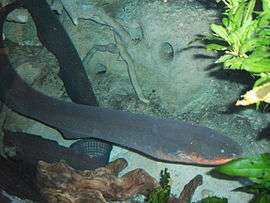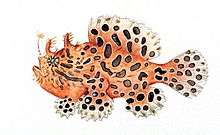Electric fish
An electric fish is any fish that can generate electric fields. A fish that can generate electric fields is called electrogenic while a fish that has the ability to detect electric fields is called electroreceptive. Most electrogenic fish are also electroreceptive.[1] Electric fish species can be found both in the ocean and in freshwater rivers of South America (Gymnotiformes) and Africa (Mormyridae). Many fish such as sharks, rays and catfishes can detect electric fields and are thus electroreceptive, but they are not classified as electric fish because they cannot generate electricity. Most common bony fish (teleosts), including most fish kept in aquaria or caught for food, are neither electrogenic nor electroreceptive.

Electric fish produce their electrical fields from a specialized structure called an electric organ. This is made up of modified muscle or nerve cells, which became specialized for producing bioelectric fields stronger than those that normal nerves or muscles produce.[2] Typically this organ is located in the tail of the electric fish. The electrical output of the organ is called the electric organ discharge.[3]
Strongly electric fish
Strongly electric fish are fish with an electric organ discharge that is powerful enough to stun prey or be used for defense. Typical examples are the electric eel, the electric catfishes, and electric rays. The amplitude of the signal can range from 10 to 860 volts with a current of up to 1 ampere, according to the surroundings, for example different conductances of salt and fresh water.[4] To maximize the power delivered to the surroundings, the impedances of the electric organ and the water must be matched:
- Strongly electric marine fish give low voltage, high current electric discharges. In salt water, a small voltage can drive a large current limited by the internal resistance of the electric organ. Hence, the electric organ consists of many electrocytes in parallel.
- Freshwater fish have high voltage, low current discharges. In freshwater, the power is limited by the voltage needed to drive the current through the large resistance of the medium. Hence, these fish have numerous cells in series.[5]
Weakly electric fish
.en2.jpg)
Weakly electric fish generate a discharge that is typically less than one volt. These are too weak to stun prey and instead are used for navigation, object detection (electrolocation) and communication with other electric fish (electrocommunication). Two of the best-known and most-studied examples are Peters' elephantnose fish (Gnathonemus petersii) and the black ghost knifefish (Apteronotus albifrons). The males of the nocturnal Brachyhypopomus pinnicaudatus, a toothless knifefish native to the Amazon basin, give off big, long electric hums to attract a mate.[7]
The electric organ discharge waveform takes two general forms depending on the species. In some species the waveform is continuous and almost sinusoidal (for example the genera Apteronotus, Eigenmannia and Gymnarchus) and these are said to have a wave-type electric organ discharge. In other species, the electric organ discharge waveform consists of brief pulses separated by longer gaps (for example Gnathonemus, Gymnotus, Leucoraja) and these are said to have a pulse-type electric organ discharge.
Jamming avoidance response
It had been theorized as early as the 1950s that electric fish near each other might experience some type of interference or inability to segregate their own signal from those of neighbors. This issue does not arise, however, because the electric fish adjust to avoid frequency interference. In 1963, two scientists, Akira Watanabe and Kimihisa Takeda, discovered the behavior of the jamming avoidance response in the knifefish Eigenmannia sp. In collaboration with T.H. Bullock and colleagues, the behavior was further developed.[8] Finally, the work of Walter Heiligenberg expanded it into a full neuroethology study by examining the series of neural connections that led to the behavior.[9] Eigenmannia is a weakly electric fish that can self-generate electric discharges through electrocytes in its tail. Furthermore, it has the ability to electrolocate by analyzing the perturbations in its electric field. However, when the frequency of a neighboring fish's current is very close (less than 20 Hz difference) to that of its own, the fish will avoid having their signals interfere through a behavior known as jamming avoidance response. If the neighbor's frequency is higher than the fish's discharge frequency, the fish will lower its frequency, and vice versa. The sign of the frequency difference is determined by analyzing the "beat" pattern of the incoming interference which consists of the combination of the two fish's discharge patterns.[9]
Neuroethologists performed several experiments under Eigenmannia's natural conditions to study how it determined the sign of the frequency difference. They manipulated the fish's discharge by injecting it with curare which prevented its natural electric organ from discharging. Then, an electrode was placed in its mouth and another was placed at the tip of its tail. Likewise, the neighboring fish's electric field was mimicked using another set of electrodes. This experiment allowed neuroethologists to manipulate different discharge frequencies and observe the fish's behavior. From the results, they were able to conclude that the electric field frequency, rather than an internal frequency measure, was used as a reference. This experiment is significant in that not only does it reveal a crucial neural mechanism underlying the behavior but also demonstrates the value neuroethologists place on studying animals in their natural habitats.[9]
Species
The following is a table of electric fish species listed by family. Most families inhabit fresh water. Two groups of marine fish, the electric rays (Torpediniformes: Narcinidae and Torpedinidae) and the stargazers (Perciformes: Uranoscopidae), are capable of generating strong electric pulses.
| Taxon | Species (348) |
|---|---|
| Gymnotiformes | |
| Apteronotidae
(Ghost knifefish, 46 species in 13 genera) |
Adontosternarchus balaenops, Adontosternarchus clarkae, Adontosternarchus devenanzii, Adontosternarchus sachsi, Apteronotus albifrons, Apteronotus apurensis, Apteronotus bonapspeciesii, Apteronotus brasiliensis, Apteronotus caudimaculosus, Apteronotus cuchillejo, Apteronotus cuchillo, Apteronotus ellisi, Apteronotus eschmeyeri, Apteronotus jurubidae, Apteronotus leptorhynchus, Apteronotus macrolepis, Apteronotus macrostomus, Apteronotus magdalenensis, Apteronotus marauna, Apteronotus mariae, Apteronotus rostratus, Apteronotus spurrellii, Compsaraia compsa, Magosternarchus duccis, Magosternarchus raptor, Megadontognathus cuyuniense, Megadontognathus kaitukaensis, Orthosternarchus tamandua, Parapteronotus hasemani, Platyurosternarchus macrostomus, Porotergus gimbeli, Porotergus gymnotus, Sternarchella curvioperculata, Sternarchella orthos, Sternarchella schotti, Sternarchella sima, Sternarchella terminalis, Sternarchogiton nattereri, Sternarchogiton porcinum, Sternarchorhamphus muelleri, Sternarchorhynchus britskii, Sternarchorhynchus curvirostris, Sternarchorhynchus mesensis, Sternarchorhynchus mormyrus, Sternarchorhynchus oxyrhynchus, Sternarchorhynchus roseni |
| Gymnotidae
(Naked-back knifefish, 29 species in 1 genus) |
Gymnotus anguillaris, Gymnotus arapaima, Gymnotus ardilai, Gymnotus bahianus, Gymnotus carapo, Gymnotus cataniapo, Gymnotus choco, Gymnotus coatesi, Gymnotus coropinae, Gymnotus cylindricus, Gymnotus diamantinensis, Gymnotus esmeraldas, Gymnotus henni, Gymnotus inaequilabiatus, Gymnotus javari, Gymnotus jonasi, Gymnotus maculosus, Gymnotus mamiraua, Gymnotus melanopleura, Gymnotus onca, Gymnotus panamensis, Gymnotus pantanal, Gymnotus pantherinus, Gymnotus paraguensis, Gymnotus pedanopterus, Gymnotus stenoleucus, Gymnotus sylvius, Gymnotus tigre, Gymnotus ucamara |
| Electrophoridae
(1 species in 1 genus) |
Electrophorus electricus (electric eel) |
| Hypopomidae
(Bluntnose knifefish, 14 species in 7 genera) |
Brachyhypopomus beebei, Brachyhypopomus brevirostris, Brachyhypopomus diazi, Brachyhypopomus janeiroensis, Brachyhypopomus occidentalis, Brachyhypopomus pinnicaudatus, Hypopomus speciesedi, Hypopygus lepturus, Hypopygus neblinae, Microsternarchus bilineatus, Racenisia fimbriipinna, Steatogenys duidae, Steatogenys elegans, Stegostenopos cryptogenes |
| Rhamphichthyidae
(Sand knifefish, 15 species in 3 genera) |
Gymnorhamphichthys hypostomus, Gymnorhamphichthys petiti, Gymnorhamphichthys rondoni, Gymnorhamphichthys rosamariae, Iracema caiana, Rhamphichthys apurensis, Rhamphichthys atlanticus, Rhamphichthys drepanium, Rhamphichthys hahni, Rhamphichthys lineatus, Rhamphichthys longior, Rhamphichthys marmoratus, Rhamphichthys pantherinus, Rhamphichthys rostratus, Rhamphichthys schomburgki |
| Sternopygidae
(Glass knifefish, 28 species in 5 genera) |
Archolaemus blax, Distocyclus conirostris, Distocyclus goajira, Eigenmannia humboldtii, Eigenmannia limbata, Eigenmannia macrops, Eigenmannia microstoma, Eigenmannia nigra, Eigenmannia trilineata, Eigenmannia vicentespelaea, Eigenmannia virescens, Rhabdolichops caviceps, Rhabdolichops eastwardi, Rhabdolichops electrogrammus, Rhabdolichops jegui, Rhabdolichops stewspeciesi, Rhabdolichops troscheli, Rhabdolichops zareti, Sternopygus aequilabiatus, Sternopygus arenatus, Sternopygus astrabes, Sternopygus branco, Sternopygus castroi, Sternopygus dariensis, Sternopygus macrurus, Sternopygus obtusirostris, Sternopygus pejeraton, Sternopygus xingu |
| Osteoglossiformes | |
| Gymnarchidae
(African knifefish, 1 species in 1 genus) |
Gymnarchus niloticus |
| Mormyridae
(Freshwater elephantfish, 203 species in 18 genera) |
Boulengeromyrus knoepffleri, Brienomyrus adustus, Brienomyrus brachyistius, Brienomyrus curvifrons, Brienomyrus hopkinsi, Brienomyrus kingsleyae eburneensis, Brienomyrus kingsleyae kingsleyae, Brienomyrus longianalis, Brienomyrus longicaudatus, Brienomyrus niger, Brienomyrus sphekodes, Brienomyrus tavernei, Campylomormyrus alces, Campylomormyrus bredoi, Campylomormyrus cassaicus, Campylomormyrus christyi, Campylomormyrus curvirostris, Campylomormyrus elephas, Campylomormyrus luapulaensis, Campylomormyrus mirus, Campylomormyrus numenius, Campylomormyrus orycteropus, Campylomormyrus phantasticus, Campylomormyrus rhynchophorus, Campylomormyrus tamandua, Campylomormyrus tshokwe, Genyomyrus donnyi, Gnathonemus barbatus, Gnathonemus echidnorhynchus, Gnathonemus longibarbis, Gnathonemus petersii, Heteromormyrus pauciradiatus, Hippopotamyrus aelsbroecki, Hippopotamyrus ansorgii, Hippopotamyrus batesii, Hippopotamyrus castor, Hippopotamyrus discorhynchus, Hippopotamyrus grahami, Hippopotamyrus harringtoni, Hippopotamyrus macrops, Hippopotamyrus macroterops, Hippopotamyrus pappenheimi, Hippopotamyrus paugyi, Hippopotamyrus pictus, Hippopotamyrus psittacus, Hippopotamyrus retrodorsalis, Hippopotamyrus smithersi, Hippopotamyrus szaboi, Hippopotamyrus weeksii, Hippopotamyrus wilverthi, Hyperopisus bebe bebe, Hyperopisus bebe occidentalis, Isichthys henryi, Ivindomyrus opdenboschi, Marcusenius rhodesianus, Marcusenius sanagaensis, Marcusenius schilthuisiae, Marcusenius senegalensis gracilis, Marcusenius senegalensis pfaffi, Marcusenius senegalensis senegalensis, Marcusenius stanleyanus, Marcusenius thomasi, Marcusenius ussheri, Marcusenius victoriae, Marcusenius abadii, Marcusenius annamariae, Marcusenius bentleyi, Marcusenius brucii, Marcusenius cuangoanus, Marcusenius cyprinoides, Marcusenius deboensis, Marcusenius dundoensis, Marcusenius friteli, Marcusenius furcidens, Marcusenius fuscus, Marcusenius ghesquierei, Marcusenius greshoffii, Marcusenius intermedius, Marcusenius kutuensis, Marcusenius leopoldianus, Marcusenius livingstonii, Marcusenius macrolepidotus angolensis, Marcusenius macrolepidotus macrolepidotus, Marcusenius macrophthalmus, Marcusenius mento, Marcusenius meronai, Marcusenius monteiri, Marcusenius moorii, Marcusenius ntemensis, Marcusenius nyasensis, Marcusenius rheni, Mormyrops anguilloides, Mormyrops attenuatus, Mormyrops batesianus, Mormyrops breviceps, Mormyrops caballus, Mormyrops citernii, Mormyrops curtus, Mormyrops curviceps, Mormyrops engystoma, Mormyrops furcidens, Mormyrops intermedius, Mormyrops lineolatus, Mormyrops mariae, Mormyrops masuianus, Mormyrops microstoma, Mormyrops nigricans, Mormyrops oudoti, Mormyrops parvus, Mormyrops sirenoides, Mormyrus bernhardi, Mormyrus caballus asinus, Mormyrus caballus bumbanus, Mormyrus caballus caballus, Mormyrus caballus lualabae, Mormyrus casalis, Mormyrus caschive, Mormyrus cyaneus, Mormyrus felixi, Mormyrus goheeni, Mormyrus hasselquistii, Mormyrus iriodes, Mormyrus kannume, Mormyrus lacerda, Mormyrus longirostris, Mormyrus macrocephalus, Mormyrus macrophthalmus, Mormyrus niloticus, Mormyrus ovis, Mormyrus rume proboscirostris, Mormyrus rume rume, Mormyrus subundulatus, Mormyrus tapirus, Mormyrus tenuirostris, Mormyrus thomasi, Myomyrus macrodon, Myomyrus macrops, Myomyrus pharao, Oxymormyrus boulengeri, Oxymormyrus zanclirostris, Paramormyrops gabonensis, Paramormyrops jacksoni, Petrocephalus ansorgii, Petrocephalus balayi, Petrocephalus bane bane, Petrocephalus bane comoensis, Petrocephalus binotatus, Petrocephalus bovei bovei, Petrocephalus bovei guineensis, Petrocephalus catostoma catostoma, Petrocephalus catostoma congicus, Petrocephalus catostoma haullevillei, Petrocephalus catostoma tanensis, Petrocephalus christyi, Petrocephalus cunganus, Petrocephalus gliroides, Petrocephalus grandoculis, Petrocephalus guttatus, Petrocephalus hutereaui, Petrocephalus keatingii, Petrocephalus levequei, Petrocephalus microphthalmus, Petrocephalus pallidomaculatus, Petrocephalus pellegrini, Petrocephalus sauvagii, Petrocephalus schoutedeni, Petrocephalus simus, Petrocephalus soudanensis, Petrocephalus squalostoma, Petrocephalus sullivani, Petrocephalus tenuicauda, Petrocephalus wesselsi, Pollimyrus adspersus, Pollimyrus brevis, Pollimyrus castelnaui, Pollimyrus isidori fasciaticeps, Pollimyrus isidori isidori, Pollimyrus isidori osborni, Pollimyrus maculipinnis, Pollimyrus marchei, Pollimyrus nigricans, Pollimyrus nigripinnis, Pollimyrus pedunculatus, Pollimyrus petherici, Pollimyrus petricolus, Pollimyrus plagiostoma, Pollimyrus pulverulentus, Pollimyrus schreyeni, Pollimyrus stappersii kapangae, Pollimyrus stappersii stappersii, Pollimyrus tumifrons, Stomatorhinus ater, Stomatorhinus corneti, Stomatorhinus fuliginosus, Stomatorhinus humilior, Stomatorhinus kununguensis, Stomatorhinus microps, Stomatorhinus patrizii, Stomatorhinus polli, Stomatorhinus polylepis, Stomatorhinus puncticulatus, Stomatorhinus schoutedeni, Stomatorhinus walkeri |
| Siluriformes | |
| Malapteruridae
(Electric catfish, 11 species in 1 genus) |
Malapterurus beninensis, Malapterurus cavalliensis, Malapterurus electricus, Malapterurus leonensis, Malapterurus microstoma, Malapterurus minjiriya, Malapterurus monsembeensis, Malapterurus oguensis, Malapterurus shirensis, Malapterurus tanganyikaensis, Malapterurus tanoensis |
| Perciformes | |
| Uranoscopidae
(Stargazers, marine fish, 50 species in 8 genera) |
Astroscopus guttatus, Astroscopus y-graecum, Astroscopus zephyreus, Gnathagnus egregius, Kathetostoma albigutta, Kathetostoma averruncus |
References
- Alves-Gomes, J (2001). "The evolution of electroreception and bioelectrogenesis in teleost fish: a phylogenietic perspective". Journal of Fish Biology. 58 (6): 1489–1511. doi:10.1111/j.1095-8649.2001.tb02307.x.
- Albert, J. S.; Crampton, W. G. R. Electroreception and electrogenesis. pp. 431–472. In: Evans, David H.; Claiborne, James B., eds. (2006). The Physiology of Fishes (3rd ed.). CRC Press. ISBN 978-0-8493-2022-4.
- Nelson, Mark. "What IS an electric fish?". Retrieved 10 August 2014.
- The Guardian: Shocking news: world's most powerful electric eel found in Amazon. Retrieved 11 Sep 2019
- Kramer, Bernd (2008). "Electric Organ Discharge". In Marc D. Binder; Nobutaka Hirokawa; Uwe Windhorst (eds.). Encyclopedia of Neuroscience. Berlin, Heidelberg: Springer. pp. 1050–1056. ISBN 978-3-540-23735-8. Retrieved 2012-03-25.
- Von der Emde, G. (1999). "Active electrolocation of objects in weakly electric fish". Journal of Experimental Biology, 202 (10): 1205–1215. Full text
- Choi, Charles. "Electric Fish Advertise Their Bodies". Retrieved 10 August 2014.
- Bullock, Theodore Holmes; Heiligenberg, Walter, eds. (1986). Electroreception. Wiley.
- Heiligenberg, Walter (1991) Neural Nets in Electric Fish Cambridge: MIT Press. ISBN 978-0-262-08203-7.
10. Know How Can Some Fishes Induce Electricity ???? on Infinite Knowledge
